
Sir Thomas Banastre KG (c. 1334 - 16 December 1379) was a Knight of the Garter from England. [1]

Sir Thomas Banastre KG (c. 1334 - 16 December 1379) was a Knight of the Garter from England. [1]
He was the son of Sir Adam Banastre (of Bretherton) and his wife Joan Petronilla (of Claughton) and was born at Bank Hall, Bretherton, Lancashire in 1334 and was the eldest of five children. [2] [3]
In 1360, he was fighting in France in the campaign led by Edward III, who also knighted at Bourg-la-Reine. Thomas was in Prince Edward's Spanish campaign in 1367 and fought at the battle of Najera on 3 April 1367. During 1369, he was in Anjou and was captured by the French and was exchanged for Sire Caponnel de Caponnat, who was held by the English. During the same year, the Hamlet of Thorp was sold by the heirs of Thorp to Thomas, which became completely merged in his moiety of Bretherton, and ceased to be noticed. This added to his estate, which consisted of farms and land which provided him with his riches. He became Knight of the Garter in 1375, and became a member of the order of the garter after the death of Walter Paveley. [3]
On 16 December 1379, Thomas Banastre was on board a fleet led by Sir John Arundel which encountered a storm in the Irish Sea, and his ship struck a rock; Thomas was drowned. Sir Hugh Calveley was aboard the same ship but survived. [3]

Thomas Holland, 2nd Baron Holand, and jure uxoris1st Earl of Kent, KG was an English nobleman and military commander during the Hundred Years' War. By the time of the Crécy campaign, he had apparently lost one of his eyes.

Sir Roger de Mortimer, 2nd Earl of March, 4th Baron Mortimer of Wigmore, KG was an English nobleman and military commander during the Hundred Years' War.

John Sutton VI, 1st Baron Dudley, KG, was an English nobleman, a diplomat, and councillor of King Henry VI. He fought in several battles during the Hundred Years War and the Wars of the Roses, in addition, he acted as Lord Lieutenant of Ireland from 1428 to 1430.

John Devereux, 1st Baron Devereux, KG, was a close companion of Edward, the Black Prince, and an English peer during the reign of King Richard II.

Enguerrand VII de Coucy,, also known as Ingelram de Coucy and Ingelram de Couci, was a medieval French nobleman and the last Lord of Coucy. He became son-in-law of King Edward III of England following his marriage to the king's daughter, Isabella of England, and the couple was subsequently granted several English estates, among them the title Earl of Bedford. Coucy fought in the Battle of Nicopolis in 1396 as part of a failed crusade against the Ottoman Empire, but was taken prisoner and contracted the bubonic plague. He died in captivity the following year at Bursa.
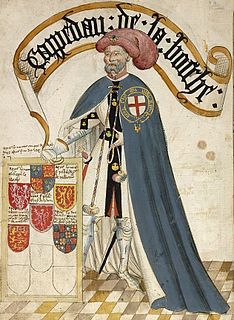
Jean III de Grailly, Captal de Buch,, was a Gascon nobleman and a military leader in the Hundred Years' War, who was praised by the chronicler Jean Froissart as an ideal of chivalry.

Robert de Holland, 1st Baron Holand was an English nobleman, born in Lancashire.

Bretherton is a small village and civil parish in the Borough of Chorley, Lancashire, England, situated to the south west of Leyland and east of Tarleton. The population of the civil parish at the 2011 census was 669. Its name suggests pre-conquest origins and its early history was closely involved with the manor house Bank Hall and the families who lived there. Bretherton remained a rural community and today is largely residential with residents commuting to nearby towns.

John Neville, 3rd Baron Neville, was an English peer, naval commander, and soldier.
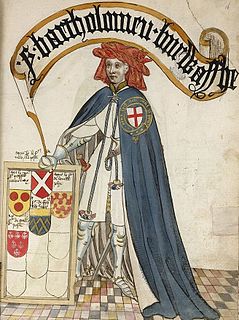
Bartholomew Burghersh, 2nd Baron Burghersh KG, called 'the younger', was an English nobleman and soldier.
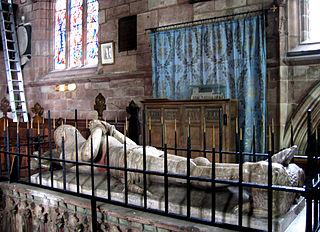
Sir Hugh Calveley was an English knight and commander, who took part in the Hundred Years' War, gaining fame during the War of the Breton Succession and the Castilian Civil War. He held various military posts in Brittany and Normandy. He should not be confused with his nephew, also Sir Hugh Calveley, who died in June 1393 and was Member of Parliament for Rutland.
Events from the 1310s in England.

Sir Richard Fitz-Simon KG, of Pensthorpe, Bawsey, and Glosthorpe, Norfolk, Letheringham, Suffolk, etc. was a founder member and 15th Knight of the Order of the Garter in 1348.
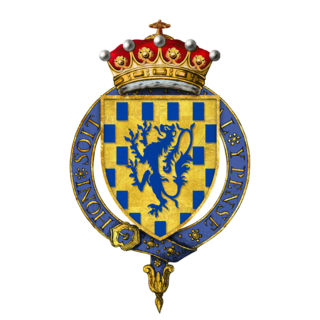
Guichard (IV) d'Angle, Earl of Huntingdon, KG was a Poitevin knight, a Knight of the Garter and a companion of Edward the Black Prince. He was born in a noble family from Angles-sur-l'Anglin in North-Eastern Poitou, sometime between 1305 and 1315.
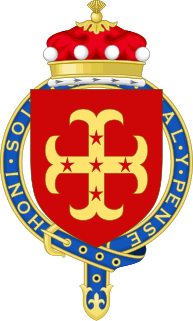
Thomas Ughtred, 1st Baron Ughtred, KG was an English soldier and politician. The eldest son and heir of Robert Ughtred, lord of the manor of Scarborough, Kilnwick Percy, Monkton Moor, and other places in Yorkshire. He was born in 1292, being eighteen years of age at his father's death, before 24 May 1310. During a distinguished career he was knighted in 1324, made a Knight banneret in 1337, a Knight of the garter between 15 May 1358 and 1360, and summoned to parliament as Baron Ughtred on 30 April 1344.

Sir Neil Loring, KG, was a medieval English soldier and diplomat and a founding member of the Order of the Garter, established by King Edward III in 1348. The central character in two historical novels by Sir Arthur Conan Doyle, Sir Nigel and The White Company, is loosely based on Neil Loring.

The Holland family was a medieval-era English noble family. Many Hollands were Earls, Dukes, Knights and Barons in medieval England, and they played significant roles in the struggles for the crown in fourteenth and fifteenth century.

William Montagu, 2nd Earl of Salisbury, 4th Baron Montagu, King of Mann, KG was an English nobleman and commander in the English army during King Edward III's French campaigns in the Hundred Years War. He was one of the Founder Knights of the Order of the Garter.

Sir John Savage, KG, KB, PC (1444–1492), was an English knight of the Savage family, who was a noted military commander of the late 15th-century. Savage most notably fought at the Battle of Bosworth Field in 1485, where he commanded the left flank of the Tudor (Lancastrian) army to victory and is said to have personally slain the Duke of Norfolk in single combat. Earlier in the Wars of the Roses, Savage had been a supporter and friend of the Yorkist King Edward IV, fighting alongside him and helping him to victories at the Battle of Barnet in 1471 and the Battle of Tewkesbury later that same year, as well as joining the Duke of Gloucester's invasion of Scotland in 1482, where the Duke made him a Knight banneret. However, following the death of Edward and the Duke of Gloucester's ascension to the throne as Richard III the Savage family was viewed with suspicion due to their familial connection to the Stanleys, who were in turn connected to the Tudors. Consequently Savage was one of the prominent figures who invited Henry Tudor to invade England in 1485, a struggle which culminated in the Battle of Bosworth Field. After his victory Henry Tudor received the circlet of Richard from Savage's uncle Lord Stanley and was crowned King of England on the field of battle, taking the throne as Henry VII of England.

Sir Thomas de Felton was an English landowner, military knight, envoy and administrator. He fought at the Battle of Crécy in 1346, and the Capture of Calais in 1347. He was also at the Battle of Poitiers in 1356. A recurrent figure in the Chronicles of Jean Froissart, he was a signatory to the Treaty of Brétigny in 1360. In 1362 he was appointed Seneschal of Aquitaine. He accompanied Edward the Black Prince on his Spanish campaign. He was taken prisoner by Henry of Trastámara's forces in 1367. In 1372 he was appointed joint-governor of Aquitaine and seneschal of Bordeaux. He caused Guillaume de Pommiers and his secretary to be beheaded for treason in 1377. He was invested a Knight of the Garter in 1381.